
February is African American History Month! ![]()
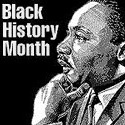
![]()
 African American art
African American art
By Richard J. Powell
Black Arts Movement, Abstraction, and Beyond
Art’s capacity to endow the artist, viewer, and others with self-affirmation and a sense of cultural authority became the benchmark for the Black Arts Movement of the late 1960s and early 1970s. During this period African American writers, performing artists, and visual artists made black culture and the political struggles of black peoples worldwide their raison d’être. Slogans like “Black Is Beautiful” and “Black Power,” as well as jazz and soul music, became the soundtrack for works by painter Murry DePillars, mixed-media artist Ben Jones, and muralist Dana Chandler. Jeff Donaldson, a cofounder of the Chicago-based black artist collective Afri-Cobra, not only added to this milieu with his own African textile-inspired, mixed-media works, but he wrote influential art manifestos and helped organize international expositions of black artists in Africa and North America.
Many artists whose careers extended back to the 1930s and 1940s resurfaced with a renewed sense of racial solidarity and political insurgency during the Black Arts Movement. Painters Lois Mailou Jones and John Biggers and sculptor and printmaker Elizabeth Catlett all aligned themselves with the younger generation of black artists, creating works that underscored their shared interest in African design sensibilities, the black figure, and the continuing struggle for civil rights.
For many abstract artists like Frank Bowling, Sam Gilliam, Richard Hunt, Barbara Chase-Riboud, and Raymond Saunders, critical and commercial success provided evidence that black artists were capable of overcoming racial obstacles and taking their rightfully earned places within the contemporary scene. These advancements were made all the more emphatic by the achievements of artists like the Washington painter Alma Thomas, who, at the age of eighty, was the first African American woman to have a solo exhibition at New York’s Whitney Museum of American Art in 1972. Artists who subscribed to a black nationalist agenda argued that Thomas (along with the other well-known black abstractionists) created works that did not challenge the aesthetic sensibilities of the white cultural mainstream. In response, abstractionists like Al Loving, Ed Clark, Joe Overstreet, Jack Whitten, and William T. Williams felt that this line of thinking showed how pervasive more conservative approaches to the visual arts were in African American communities. Both positions demonstrated how difficult it was for even the most sophisticated art connoisseurs to glean cultural elements out of abstractions. The same myopia often existed in interpretations of works by folk artists like Clementine Hunter and the evangelist-turned-painter Sister Gertrude Morgan.
As artists and audiences grew more conversant in the diverse ways that one could express black culture, the 1970s and 1980s ushered in a variety of artists and artworks all comfortably operating under the rubric of Afro-American art. From the photorealism of painter Barkley L. Hendricks and neomannerist stylizations of painter Ernie Barnes to the cloth-and canvas accretions of mixed-media artist Benny Andrews and altar-like installations of sculptor Betye Saar, African American art could no longer be contained in neat, stylistic categories. The important exhibitions of past and present African American art organized by curators David C. Driskell and Edmund B. Gaither and the definitive histories and art publications of Elsa Honig Fine, Samella Lewis, and Ruth Waddy helped educate the experts and uninformed public alike on all that might constitute an African American art.
Examples:

Alma Thomas (American, 1891-1978), Leaves Outside a Window in Rain, 1966, watercolor on paper. See feminism and feminist art.
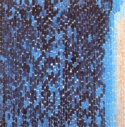
Alma Thomas, New Galaxy, 1970, synthetic polymer on canvas, 54 x 54 inches. See color-field painting.
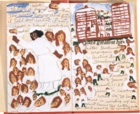
Sister Gertrude Morgan (American, 1900-), God's Greatest Hits, 1978, tempera on paper. See folk art.
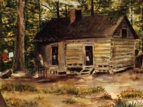
Loïs Mailou Jones (American, 1905-1998), Negro Shack I, Sedalia, North Carolina, 1930, watercolor on paper, 15 x 20 inches.

Loïs Mailou Jones, Fishing Smacks, Menemsha, Massachusetts, 1932, watercolor on paper, 20 1/4 x 26 1/2 inches.
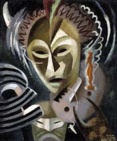
Loïs Mailou Jones, Les Fétiches,
1938, oil on canvas,
21 x 25 1/2 inches,
Smithsonian American Art Museum, Washington, DC.
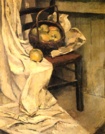
Loïs Mailou Jones, Les Pommes Vertes (The Green Apples), 1938, oil on canvas, 36 x 28 1/4 inches. This picture was exhibited at the Société des Artistes Français, Paris, 1938.
![]()

Loïs Mailou Jones, Jennie, 1943, oil on canvas, 41 3/4 x 34 inches.

Loïs Mailou Jones, The Lovers (Somali Friends), 1950, casein on canvas.

Elizabeth Catlett (Mexican, born and active in America, 1919-), Sharecropper, 1968, color linoleum cut on paper. See feminism and feminist art.

Elizabeth Catlett, Ife, 2002, carved mahogany, Chrysler Museum of Art, Norfolk, VA. See nude and wood.
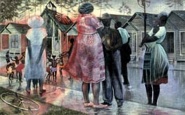
John Biggers (American, 1924-), Shotgun, Third Ward #1, 1966, tempera and oil, 30 x 48 inches, Smithsonian American Art Museum, Washington, DC.

John Biggers, Starry Crown, 1987, acrylic on canvas, 59 1/2 x 47 1/2 inches, Dallas Museum of Art.
![]()
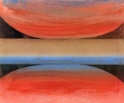
Ed Clark (American, 1926-), Untitled, 1978, etching on paper.
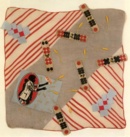
Betye Saar (American, 1926-), Dat Ol' Black Magic, 1981, mixed media.

Faith Ringgold (American, 1930-), The Flag is Bleeding #2, acrylic on canvas, painted and pieced border, 76 x 79.5 inches, from the series "The American Collection," #6. See feminism and feminist art and flag. Visit the artist's Web site.
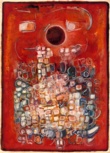
David C. Driskell (American, 1931-), Movement, The Mountain, 1980, egg tempera on canvas.
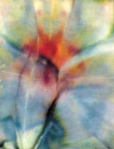
Sam Gilliam (American, 1933-), Abstraction, 1969, acrylic on aluminum-treated paper. See abstraction.

Sam Gilliam, Open Cylinder,
1979, oil on canvas,
cut and pieced, 81 x 35 1/2 inches,
Smithsonian American Art Museum, Washington, DC.
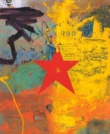
Raymond Saunders (American, 1934-), Red Star, 1970, oil on canvas.

Richard Hunt (American, 1935-),
Hero Construction, 1958, found steel, welded and chromed, height 175.3 cm, Art Institute of Chicago.

Alvin D. Loving, Jr. (American, 1935-2005), WYN...Time Trip I, 1971, synthetic polymer on canvas, 147 x 324 cm.

Frank E. Smith (American, 1935-), River of Darkness, 1986, acrylic and ink on paper.
This is part 7 of ArtPage on African American art
_____
The author of this article, Richard J. Powell PhD, is a professor of art and art history at Duke University who specializes in American, African American and African art. His books include Homecoming: The Art and Life of William H. Johnson (1991), Rhapsodies in Black: Art of the Harlem Renaissance (1997), and Black Art: A Cultural History (2002).
Copyright © 2005 Oxford University Press. All rights reserved. Excerpted from Africana: The Encyclopedia of the African and African American Experience, second edition. Edited by Henry Louis Gates Jr. and Kwame Anthony Appiah. Thanks to Yolanda Carden for permission to post this excerpt in ArtPage.
Oxford University Press; April 2005; 5 Volumes; 4,500 pp.; 0-19-517055-5; Special introductory price until April 30th, 2005 of US $425.00. After April 30th, 2005, the price will be US $500.00. Please visit the Oxford University Press for ordering information.
Ninety years after W.E.B. Du Bois first articulated the need for “the equivalent of a black Encyclopedia Britannica,” Kwame Anthony Appiah and Henry Louis Gates Jr., realized his vision by publishing Africana: The Encyclopedia of the African and African American Experience in 1999. This new multi-volume edition of the original work expands on the foundation provided by Africana. More than 4,000 articles cover prominent individuals, events, trends, places, political movements, art forms, business and trade, religion, ethnic groups, organizations and countries on both sides of the Atlantic.
![]() About the Editors:
About the Editors:
Henry Louis Gates, Jr. is W. E. B. Du Bois Professor of Humanities, Chair of the Department of African and African American Studies, and Director of the W. E. B. Du Bois Institute for African and African American Research, Harvard University. Professor Gates is well known as an innovator in the field of African American studies and as the author of numerous works.
Kwame Anthony Appiah is the Lawrence S. Rockefeller Professor of Philosophy and the University Center for Human Values at Princeton University.
Also see African art, Afrocentrism, bias, discrimination, ethnic, ethnocentrism, multiculturalism, xenophilia, and xenophobia.
https://inform.quest/_art
Copyright © 1996-![]()